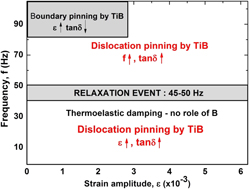Article contents
Effect of hypoeutectic boron modification on the dynamic properties of Ti-6Al-4V alloy
Published online by Cambridge University Press: 04 July 2016
Abstract

The effect of boron on the room-temperature dynamic properties of Ti-6Al-4V alloy with and without boron addition in as-cast and β-forged conditions is studied by varying number of loading cycles, frequency of loading, and strain amplitude. Boron addition seems to lower the complex modulus and increases the damping of the base Ti-6Al-4V alloy. TiB precipitates in boron modified alloys play a key role in improving the damping through dislocation pinning (at all frequencies) and grain boundary pinning (at high frequencies). These effects are more prominent after β-forging wherein arrangement of TiB particles is found to be a deciding factor. Strain amplitude variation of damping shows trend reversal between 10 and 87 Hz frequencies; damping increases with strain amplitude at 10 Hz but reduces with strain amplitude at 87 Hz. A damping peak occurs near the 50 Hz frequency, and cycling through this range results in a significant improvement in damping (21% for as-cast and 93% for β-forged alloys).
Keywords
- Type
- Focus Section: Reinventing Boron Chemistry and Materials for the 21st Century
- Information
- Journal of Materials Research , Volume 31 , Issue 18: Focus Section: Reinventing Boron Chemistry for the 21st Century , 28 September 2016 , pp. 2804 - 2816
- Copyright
- Copyright © Materials Research Society 2016
References
REFERENCES
- 5
- Cited by



